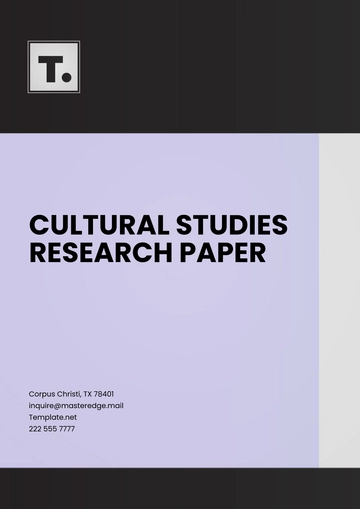Free Sample Research

Conducted By: [Your Name]
1. Introduction
The research embarked on a thorough examination of gender representation within the media landscape, with a specific emphasis placed on the pervasive presence of stereotypes and portrayals. Its overarching objective was to delve into the multifaceted dimensions of these portrayals and discern their implications for the sociocultural fabric.
Media plays a formidable role in shaping societal perceptions and norms, wielding considerable influence over attitudes, behaviors, and expectations related to gender. Within this context, this study endeavors to unravel the intricate tapestry of gender portrayals manifested across diverse media platforms. Through meticulous analysis, it aims to unearth insights that illuminate the intricate interplay between media content and the deeply ingrained cultural constructs surrounding gender.
Understanding the nuances of gender representation in media is paramount due to its profound impact on shaping societal norms and perceptions. By scrutinizing portrayals across various media forms, this research aspires to contribute to a deeper comprehension of how media content both reflects and perpetuates prevailing gender ideologies. Through this exploration, it seeks to shed light on the mechanisms through which media influences and reinforces cultural norms and expectations regarding gender roles and identities.
2. Literature Review
Gender representation in media has been a subject of extensive research, with scholars delving into its nuanced dimensions and implications. The existing body of literature provides a comprehensive overview of the pervasive influence of media portrayals on societal perceptions and norms, particularly concerning gender stereotypes.
Stereotypes within media narratives have been identified as potent contributors to the perpetuation of misconceptions and biases regarding gender roles and identities. These portrayals often depict narrow and harmful notions, reinforcing entrenched societal attitudes and expectations. Dines and Humez (1995) highlighted the intersectionality of gender, race, and class in media, underscoring the complex interplay of multiple factors in shaping portrayals.
Efforts to reform these representations have seen some progress, with increased awareness and advocacy for more diverse and authentic portrayals. However, significant challenges persist, reflecting the enduring prevalence of gender stereotypes within media content. Signorielli and Bacue (1999) conducted a content analysis of prime-time television characters over three decades, revealing persistent patterns of gender representation.

The persistence of stereotypes within media narratives underscores the need for continued scrutiny and intervention to foster a more inclusive and equitable media landscape. Lauzen, Dozier, and Cleveland (2006) emphasized the importance of genre in shaping gender representations, highlighting the need for nuanced analysis across different media forms.
Understanding and challenging these stereotypes are crucial steps toward fostering positive change within the media landscape. Collins (2011) advocated for ongoing content analysis to track progress and identify areas for improvement, emphasizing the importance of promoting diverse voices and perspectives.
3. Research Methodology
The research methodology employed in this study is rooted in content analysis, providing a structured framework for examining gender representation within media. By systematically analyzing media content, researchers aim to identify and quantify gender-related themes and biases. The methodology encompasses a diverse range of media types, ensuring a comprehensive exploration of gender portrayal across various mediums and contexts.
Content Analysis: The research relies on content analysis as the primary methodological approach. This systematic examination of media content enables the identification and quantification of gender-related themes and biases.
Diverse Sample Selection: The sample includes various media types such as television show episodes, movies, print media, and social media platforms. This diverse sampling strategy ensures a comprehensive understanding of gender representation across different mediums and contexts.
Comprehensive Analysis: By encompassing a broad spectrum of media content, the research aims to achieve a thorough analysis of gender portrayals. This approach facilitates the detection of patterns and trends in gender representation, shedding light on both explicit and implicit biases present in contemporary media narratives.
Coding Process: The analysis involves a meticulous coding of media content, wherein researchers categorize and analyze gender-related themes and representations. This coding process allows for the identification of recurring motifs and stereotypes, providing valuable insights into the construction of gender within media discourse.
Insight Generation: Through the content analysis process, the research seeks to generate valuable insights into the prevailing societal norms and expectations surrounding gender roles and identities. By interrogating media content across various platforms, researchers aim to elucidate the ways in which gender is constructed and represented within media narratives.
4. Data Collection and Analysis
In this phase of the research, data collection and analysis were conducted meticulously to ensure a rigorous and unbiased examination of gender representation within the media. The process involved manual coding of a randomly selected sample from the intended media sources.
To begin, researchers systematically selected a representative sample of media content from various sources, including television shows, movies, print media, and social media platforms. This diverse selection aimed to capture a broad spectrum of gender portrayals across different forms of media.
Comparison of Gender Representation Across Different Media Platforms
The manual coding process was then employed to analyze the selected media content. Researchers carefully reviewed each piece of media, identifying and categorizing gender-related themes and representations. This coding process allowed for the systematic organization of data, facilitating the identification of recurring motifs and patterns in gender portrayal.
Importantly, the random selection of media samples helped mitigate bias and ensure the integrity of the analysis. By employing a randomized approach, researchers aimed to achieve an unbiased representation of gender portrayals within the media landscape.
Throughout the data collection and analysis process, researchers adhered to rigorous methodological standards to maintain the validity and reliability of the findings. By employing manual coding techniques and random sampling procedures, researchers sought to generate comprehensive insights into the nuanced complexities of gender representation within media.
5. Findings and Discussions
The findings of this study are presented in a structured manner, with each section summarizing observations from various media types. Through this organization, the research aims to provide a comprehensive overview of gender representation across different platforms. The discussion section synthesizes the implications of these findings, examining their impact on gender perceptions and societal norms. By systematically analyzing the portrayal of gender, the study endeavors to uncover the intricate ways in which media shapes and perpetuates gender stereotypes and biases.
Through a nuanced analysis of the data, the discussion delves into the broader cultural implications of these representations. It explores how media portrayals influence individuals' attitudes, beliefs, and behaviors related to gender, shedding light on the complex interplay between media content and societal norms. Furthermore, the study critically engages with the findings to provide insights into potential strategies for mitigating the negative effects of gender stereotypes in media. By offering recommendations for promoting more inclusive and diverse representations, the research aims to contribute to the ongoing discourse surrounding gender representation within media.
6. Conclusion
The conclusion drawn from the systematic analysis of gender representation in media reveals the pervasive presence of gender stereotypes and their potential socio-cultural implications. Despite efforts to promote diversity and authenticity in media portrayals, the study underscores the persistent prevalence of narrow and often harmful gender stereotypes.
However, amidst these pervasive stereotypes, the analysis also identifies instances where media has served as a progressive force. These "bright spots" highlight instances of media content that challenge traditional gender norms and offer more inclusive and empowering representations of gender.
Overall, the conclusion emphasizes the need for continued scrutiny and intervention to address the perpetuation of gender stereotypes within media. By acknowledging both the challenges and opportunities presented by media portrayals, the research underscores the importance of promoting more nuanced and representative depictions of gender in media content. Through concerted efforts to challenge stereotypes and promote inclusivity, the study aims to contribute to the creation of a more equitable and empowering media landscape.
7. Suggestions and Future Work
As the study draws to a close, it offers a set of actionable suggestions aimed at fostering a more equitable representation of gender in the media landscape. Additionally, it outlines potential avenues for future research that can build upon the findings of this study.
Implement Guidelines for Gender Portrayal: One recommendation is to establish clear guidelines or standards for gender portrayal in media content. These guidelines can help media producers create more diverse and authentic representations of gender, thereby challenging stereotypes and promoting inclusivity.
Promote Marginalized Voices: Another suggestion is to actively promote the voices and perspectives of marginalized groups within media narratives. By amplifying underrepresented voices, media content can better reflect the diversity of human experiences and contribute to a more inclusive societal discourse.
Foster Collaborations: The study proposes fostering collaborations between media industries and advocacy organizations. By working together, these stakeholders can develop initiatives and campaigns aimed at promoting more positive and empowering representations of gender in media content.
Explore Intersectionality: There is a need to explore the intersectionality of gender with other social categories such as race, class, and sexuality in media representation. This intersectional approach can deepen our understanding of how multiple axes of identity intersect and influence media portrayals, leading to more nuanced analyses and interventions.
Investigate Digital Platforms: Lastly, the study suggests investigating the impact of emerging digital platforms on evolving gender norms. With the proliferation of digital media, understanding how these platforms shape and are shaped by gender representations is crucial for navigating the contemporary media landscape.
These suggestions and avenues for future research aim to address the complex challenges surrounding gender representation in media and contribute to ongoing efforts to create a more equitable and inclusive media environment. By taking proactive steps and exploring new directions in research, stakeholders can work towards fostering positive change within the media landscape.
8. References
Dines, G., & Humez, J. M. (1995). Gender, race, and class in media. Thousand Oaks, CA: Sage Publications.
Signorielli, N., & Bacue, A. (1999). Recognition and respect: A content analysis of prime-time television characters across three decades. Social Forces, 77(3), 823-846.
Lauzen, M. M., Dozier, D. M., & Cleveland, E. (2006). Genre matters: An examination of women working behind the scenes and on-screen in prime-time television. Journal of Broadcasting & Electronic Media, 50(4), 631-648.
Collins, R. L. (2011). Content analysis of gender roles in media: Where are we now and where should we go? Sex Roles, 64(3-4), 290-298.
Gerbner, G., Gross, L., Morgan, M., & Signorielli, N. (1994). Growing up with television: The cultivation perspective. In Media effects: Advances in theory and research (pp. 17-41). Hillsdale, NJ: Lawrence Erlbaum Associates.
- 100% Customizable, free editor
- Access 1 Million+ Templates, photo’s & graphics
- Download or share as a template
- Click and replace photos, graphics, text, backgrounds
- Resize, crop, AI write & more
- Access advanced editor





























